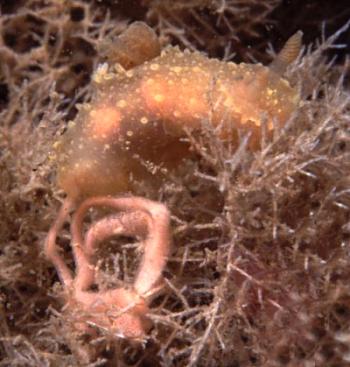
Palio dubia
(M. Sars, 1829)
Order: NUDIBRANCHIA
Suborder: DORIDINA
Superfamily: ANADORIDOIDEA
Family: Polyceridae
DISTRIBUTION
North Atlantic. European and possibly North American coasts.
PHOTO
East coast of Denmark, near Kolding, Spring 2000. Photos: Peter van Bragt.
Body elongate, olive green with white or yellow tubercles and papillae. The lamellate rhinophores and the tripinnate gills are translucent in colour and number up to 5. The turbercles and frontal papillae are pale yellow. Whitish compound papillae are situated on either side of the branchial circlet as well as the median longitudinal, dorsal metapodial papillae.
See Bernard Picton's comments below about the confusion in the literature between this species and Palio nothus (Johnston, 1838).
References:
• Sars, M. (1829) Bidrag til soedyrenes naturhistorie, Bergen, pt. 1, p. 1-59, pls. 1-6.
• Thompson,T.E. (1988) Molluscs: Benthic Opisthobranchs (Mollusca: Gastropoda). E.J.Brill / Dr W.Backhuys. 356pp.

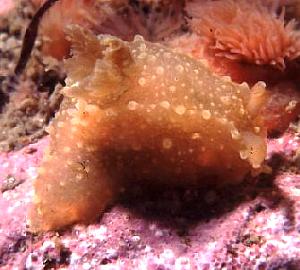
Rudman, W.B., 2000 (September 17) Palio dubia (M. Sars, 1829). [In] Sea Slug Forum. Australian Museum, Sydney. Available from http://www.seaslugforum.net/find/palidubi
Related messages
Palio dubia from Puget Sound, Washington
April 21, 2006
From: Jan Kocian
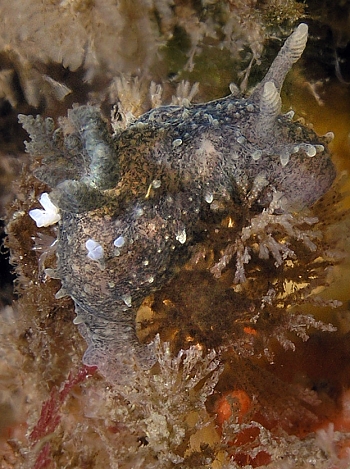
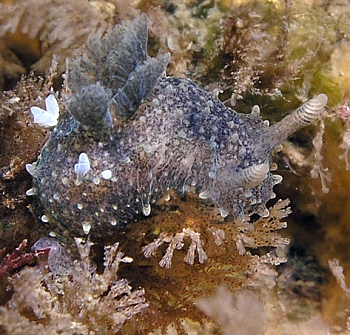
Hi Bill.
Looking at photo of common Janolus fuscus after dive on my computer screen, I noticed a small slug in the background [see message #16399]. Dave Behrens confirmed it to be Palio dubia and asked me to try collect a specimen. Luck stayed with me, next day as I was zooming in on Diaulula sandiegensis, there was that little dorid feeding on its favored bryozoan food, Bugula nerita [see message #16400].
Locality: Whidbey Island, Puget Sound, 6 feet, Washington USA, Eastern Pacific Ocean, 30 March 2006, harbor seawall. Length: 22 mm. Photographer: Jan Kocian.
Jan.
honkoc@hotmail.com
Kocian J., 2006 (Apr 21) Palio dubia from Puget Sound, Washington. [Message in] Sea Slug Forum. Australian Museum, Sydney. Available from http://www.seaslugforum.net/find/16221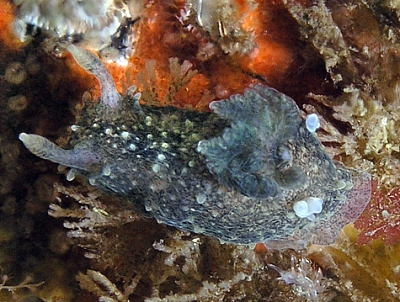
Dear Jan,
This is an interesting find and may help to decide whether the west coast and east coast Nth American populations are the same or different from the European populations of this species. For those unfamiliar with bryozoans, which this genus of polycerids feed on, the bushes in Jan's photos are in fact the plant-like colonies of these animals..
Best wishes,
Bill Rudman
German common name for Palio dubia
July 30, 2005
From: Dirk Schories
Dear seaslug participants,
I am looking for a German name of the species "Palio dubia ", but did not find any in the literature. If somebody of you knows a name or can suggest a name (will be published by KOSMOS in a small booklet), it would be great if you can send it to me.
Greetings
Dirk
Dr. Dirk Schories
Institute for Aquatic Ecology
BioSciences
University of Rostock
dirk.schories@gmx.de
Schories, D., 2005 (Jul 30) German common name for Palio dubia. [Message in] Sea Slug Forum. Australian Museum, Sydney. Available from http://www.seaslugforum.net/find/14307Dear Dirk,
I am not very much in favour of common names. The fact that you can't find one easily seems to me to demonstrate that there isn't a common name - in the sense of a 'commonly used' name. I suspect you are going to have to make one up - which will prove that the name you make up isn't a 'common' name. Why not encourage the 'common' people to use the only true, universal name for the species, which is Palio dubia.
Best wishes,
Bill Rudman
Palio dubia? from Norway
July 10, 2003
From: Robert Borzymek
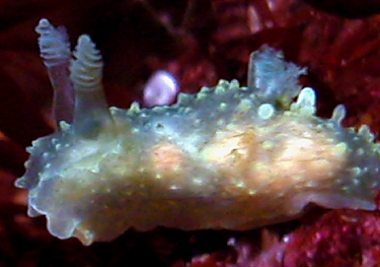
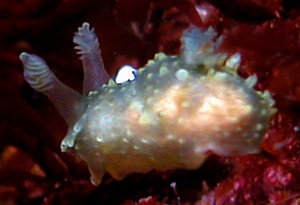
Dear Bill,
I took these photos at Lofoten Island in Norway, inside the Arctic Circle. It was at about 30 meters. I saw them only twice in different dive sites in Lofoten during my two weeks diving trip. Could you please help my identify them.
Best regards
Robert Borzymek
www.md.mcnet.pl
r.borzymek@millenniumdivers.mcnet.pl
Borzymek, R., 2003 (Jul 10) Palio dubia? from Norway. [Message in] Sea Slug Forum. Australian Museum, Sydney. Available from http://www.seaslugforum.net/find/10356Dear Robert,
I suspect these are Palio dubia but the one in the lower photo seems to be damaged posteriorly. I could be quite wrong so lets see what some of our colleagues from the cold north have to say
Best wishes,
Bill Rudman
Palio dubia from New England
July 14, 2002
From: Alan Shepard
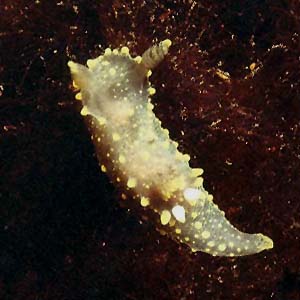
Bill -
While doing some checking on some of our local (New England / western Atlantic) nudibranchs I noticed you only had photos of Palio dubia, 'the rim-backed nudibranch' from the eastern Atlantic. Here is one from our side of the Atlantic. The coloration is a bit different, closer to the greenish description that is often mentioned.
This one was photographed in about 15 feet of water here in New England. It was small. I was using a Nikonos V with a 1:1 extension tube so as you can see the nudibranch was much shorter than the width of a 35mm slide.
Regards,
Alan Shepard
aetobatus@aol.com
Shepard, A., 2002 (Jul 14) Palio dubia from New England. [Message in] Sea Slug Forum. Australian Museum, Sydney. Available from http://www.seaslugforum.net/find/5896Thanks Alan,
A useful addition to the NW Atlantic collection.
Bill Rudman
Palio from Denmark is P. dubia
September 22, 2000
From: Bernard Picton
Hi Bill,
Yes, I agree with Kathe that this is Palio dubia. Much of the confusion in the literature regarding these two species is due to the fact that they have been wrongly synonymised several times and the older name is P. dubia. Then all the records of P. nothus get attributed to the name dubia!
P. dubia is much the rarer of the two species (in number of records) occurring sublittorally in 20 metres or more normally, whilst P. nothus is often found intertidally. The bryozoan in Peter's photo looks like Eucratea loricata, which is the food of P. dubia, while P. nothus feeds on Bowerbankia species.
Palio dubia is a northern species with us in the UK so I'd expect it in the North Sea. Indeed I see that it is recorded right up into Northern Norway and Greenland in Just and Edmunds North Atlantic Nudibranchs seen by Henning Lemche. According to the distribution charts there it is recorded from the area E. Denmark & Sweden W coast, but not from W Denmark and Skagerrak, but in any case there could be confusion in the literature due to the name changes I've mentioned.
Bernard
bernard.picton.um@nics.gov.uk
Picton, B., 2000 (Sep 22) Palio from Denmark is P. dubia. [Message in] Sea Slug Forum. Australian Museum, Sydney. Available from http://www.seaslugforum.net/find/3064Dear Bernard,
Thanks to you and Kathe for sorting this out
Bill Rudman.
Re: Palio nothus from Denmark
September 21, 2000
From: Kathe R. Jensen
Dear Peter & Bill,
I think the species on Peter's pictures is actually Palio dubia (M.Sars). The Palio nothus I have seen in Denmark have been much darker, with a reticulate pattern of the dark pigment, which as I remember it, was brown rather than green. Unfortunately I did not bring my Danish slides to Thailand, so I cannot check. But have a look at the pictures in Bernard Picton & Christine Morrow's book on British nudibranchs (pp. 76-77).
Kathe
jensen@ait.ac.th
Jensen, K.R., 2000 (Sep 21) Re: Palio nothus from Denmark. [Message in] Sea Slug Forum. Australian Museum, Sydney. Available from http://www.seaslugforum.net/find/3050Thanks Kathe,
I found the literature concerning these two species to be extremely confusing. Certainly most of the illustrations of both species look different from Peter's. It doesn't really look like either of the species as illustrated on Bernard Picton's website at: http://www.pictonb.freeserve.co.uk/nudibranchs/index.html.
Before I change the identification I would welcome some more advice from those familiar with the Atlantic fauna.
Best wishes,
Bill Rudman.
Palio nothus from Denmark
September 20, 2000
From: Peter H. van Bragt

Hallo Bill,
Enclosed you will find images of Palio nothus that I have recently found in Denmark
This specimen with its spawn was found at the east coast of Denmark, near Kolding in the Spring of 2000.
Palio nothus is very rare in the Netherlands. So far it has only been recorded to be found seven times. I have not seen this one myself yet on the Dutch coast.
Please add this image also to the list of Dutch records so that our nudi-spotters may recognize it if they find one in the Netherlands again.
Best regards
Peter H. van Bragt
vanbragt.phjm@hsbrabant.nl


Thanks Peter,
I am unfamiliar with this species. Is this a 'typical' colour form? It looks a bit different from most of the illustrations I have seen with descriptions of a greenish background colour.
Best wishes,
Bill Rudman.
